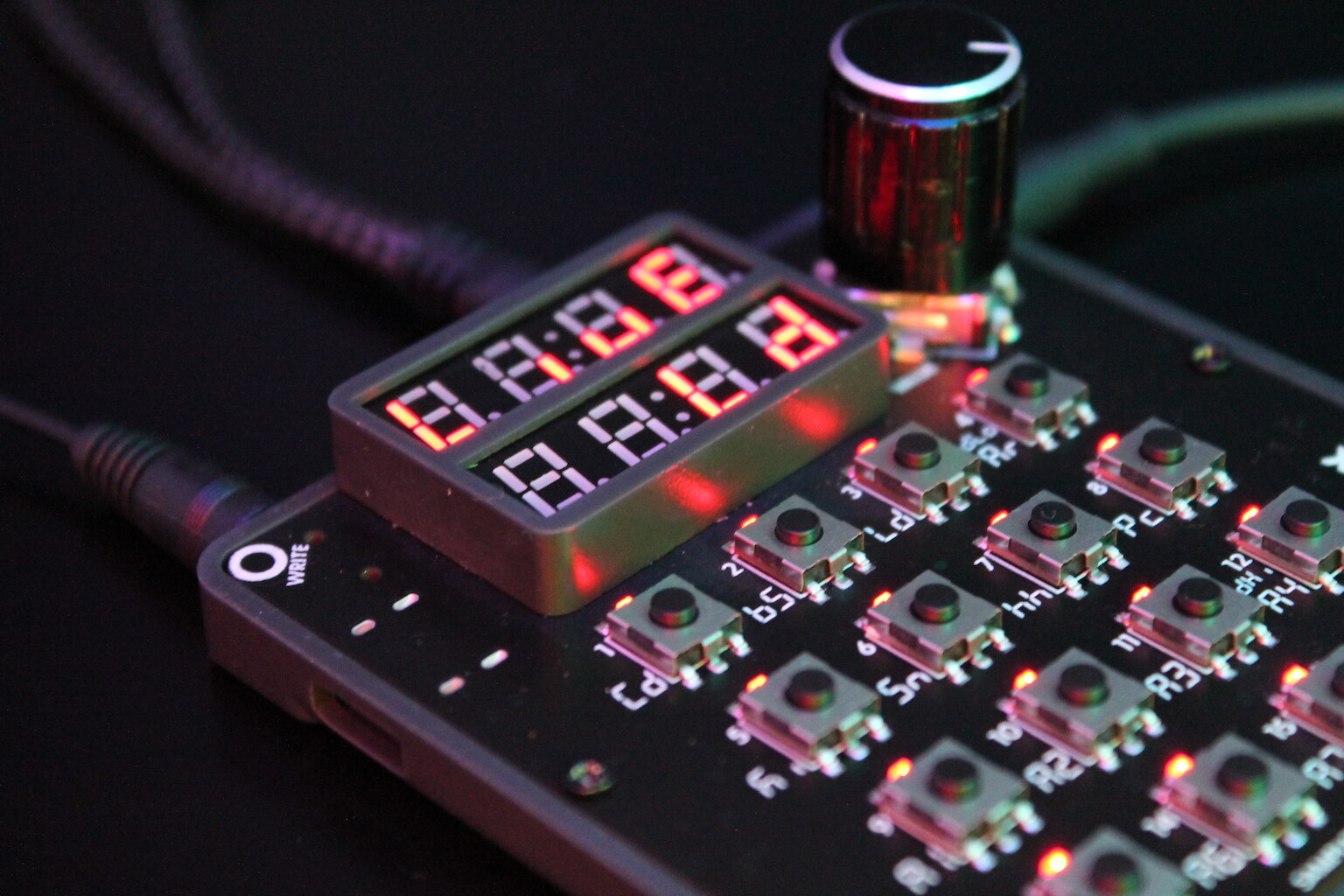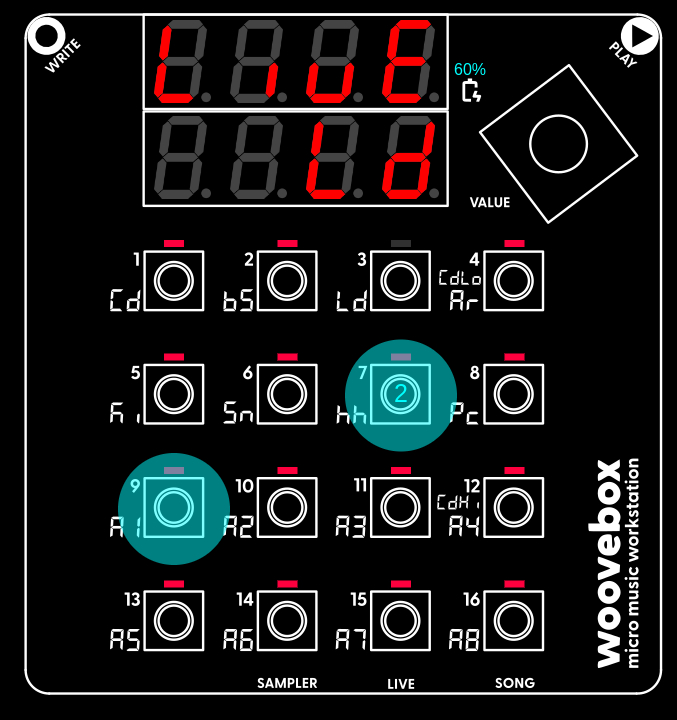- Guides, tutorials and docs
- Learning the Woovebox
- The very basics
- Quick start tutorial and video
- Tempo and BPM
- Tracks
- Patterns
- Live pattern recording
- Conditional triggering and modification
- Chords
- Arpeggios
- Scales and modes
- Genres
- Patches and Presets
- Sound design
- Paraphonic parts
- Multi-instrument mode
- Risers, fallers, sweeps & ear candy
- Live mode
- Song mode
- Full song writing
- Sampler & vocoder
- Sidechaining, gating, ducking and compression
- Mastering
- Lo-fi & vintage analog and digital emulation
- Randomization
- Hall effect sensor playing
- Advanced techniques
- Undo
- Boot modes
- MIDI, Sync and connecting other gear
- Remote control expander mode
- Wireless MIDI over Bluetooth
- Battery and charging
- Hardware quirks and limitations
- Understanding DSP load
- Looking after your Woovebox
- Firmware updates
- Guides, tutorials and docs
- Live mode
Live mode

In Live mode, your Woovebox becomes a performance instrument and classic groovebox. Live mode allows you to improvise melodies, switch tracks on and off real-time, or trigger "scenes" (pre-programmed track behaviors) to build up and a song dynamically as part of a live performance.
When connected up to other gear via wired or wireless MIDI, audio input, and/or analog sync pulse out, your Woovebox can act as the brain of a bigger setup.
To access Live mode, hold the value knob and short-press 15/A7/Live.
Toggling tracks on and off
To toggle tracks on and off, hold write and press 1/Cd-16/A8 to toggle on or off tracks. Hitting play, you should hear the tracks being played back. You can toggle on and off tracks like this during your performance.
TIP: You can carry over your configuration of muted and unmuted tracks into track/pattern edit mode, by holding the value knob and holding the track 1/Cd-16/A8 you wish to edit. In other words, this feature allows you to solo and mute tracks at will while working on your patterns and tracks.
You can play along in real-time with the tracks by playing key 1-16. The track that will be sounded when you play key 1-16, is indicated on the lower display. To change which track is sounded when you hit a key, hold play until "Slct Trak" ("select track"), then while still holding play, select track 1/Cd-16/A8 to switch to that track. The new track should now be indicated in the lower display.
Scenes
Scenes are pre-programmed track configurations that play out over a specified time. By triggering them (either immediately, or by scheduling them in the future), you build up tracks during your live performance.
To access scene programming mode, hold the value knob and short-press 15/A7/Live once or twice, until the first two characters of screen read "Sc.". To exit scene programming mode and return to Live performance ("Live") mode, press hold the value knob and short-press 15/A7/Live once more.
The number following "Sc." indicates which scene is currently active. You can program or trigger up to 16 scenes. To change the scene you are programming, hold play and press 1-16 to select scene 1-16.
Programming a scene is nearly identical to programming a song fragment in Song mode. Hold Write and press all the 1/Cd through 16/A8 tracks you wish to sound when the scene is active.
Just like editing a note in Track edit mode or editing track parameters when editing a song fragment, you can hold an active (lit up) track's key (1/Cd-16/A8) until it blinks and then cycle through the parameters you can change by short pressing the value knob.
Still holding the track's key (1/Cd-16/A8), you can change the parameter by turning the value knob.
Per track, you can change the following parameters;
- Playing behavior ("bhev");
- Pattern number ("Pttn");
- Chord lock ("Cd.Lk");
- Re-trigger effect ("retr");
A scene has a length associated with it, over which it plays out and then loops. Just like in other places where you specify a length, you can change the scene length by holding write and turning the value knob. The playing behavior ("bhev") you specified, plays out over the specified length as well. This allows you to program and trigger filter sweeps, fade ins and fade outs of individual tracks.
For more information on automation and re-triggering effects, please see the Song mode documentation.
Performing with Live mode
Perfoming on your Woovebox in Live mode is straightforward, powerful and rewarding.
At any time, you can play along, create melodies and improvise in real-time by playing key 1-16. The track that will be sounded when you play key 1-16, is indicated on the lower display. To change which track is sounded when you hit a key, hold play until "Slct Trak" ("select track"), then while still holding play, select track 1/Cd-16/A8 to switch to that track. The newly selected track should now be indicated in the lower display.
Before hitting play to start your performance, you may wish to activate a scene to start with (or quickly mute/unmute some tracks by holding write and selecting track 1/Cd-16/A8). Scenes are pre-programmed track configurations that play out over a specified time. For example, you can have one scene that has the kick and hi-hat playing, and another that has the kick, hi-hat and bass playing. Switching between the two scenes builds your track.
To activate the scene you wish to start with, hold play and short-press key 1-16 to choose scene 1-16. The screen will briefly show "Copy Sc." followed by the scene number you selected. You will now notice the tracks have been configured (e.g. muted and unmuted) according to the scene.You can this this during playback as well to jump between scenes and thus track configurations.
A more convenient way to switch between scenes during playback, is to schedule a scene. This makes sure that a scene is triggered when the currently playing scene is elapsed. This can avoid jarring or badly timed transitions (though sometimes jarring might be exactly the sound you are after of course). To schedule a scene transition, hold play and long-press key 1-16 to schedule scene 1-16. The display will indicate "Schd Sc." ("scheduled scene") followed by the scene number you selected. The scene will now only start playing once its starting position is synced up with the playhead. You will see the playhead going in reverse to give you a visual indication of when the new scene will trigger.
Live jamming

Despite its limitations, the Woovebox keyboard can be surprisingly expressive and very much suitable for live playing and improvising complex melodies.
Combined with legato, you can even dynamically create pitch glides; hold 1-16, then quickly play another 1-16 to slide from the first held 1-16 pitch to the second played 1-16 pitch. Note that to use glides, the patch needs to be configured to allow this. You can configure your patch on the 'Pich' (pitch) page; set Live Glide (LLGL) under 3/Ld to 'on'. Then set Legato Speed (LEG.S) under 7/hh to a value other than 0 to control the glide speed.
The way the keyboard translates key presses into note pitches, depends on how the FLW.C (follow chord) parameter on the 'Glob' (global) page is configured for your patch. For example, key presses may be automatically "pulled" toward the root note of the chord that is currently playing, or key presses may be automatically translated to the "legal" notes of the musical scale for your song. Please refer to the documentation to learn more about all the different modes at your disposal.
You may also be interested in...
- Launch Wooveconnect
Manage songs, samples, audio stems, firmware updates and more through Wooveconnect.
- Gating off (under Example)
- 5. AEG.d Amplitude Envelope Generator depth (under Osc1 and Osc2 oscillator page)
Defines the strength and nature of the effect of the Amplitude Envelope Generator (AEG).
- Chord progression without inversions (under Example)
- Chord progression with random inversions (under Example)
- Guides, tutorials and docs
- Learning the Woovebox
- The very basics
- Quick start tutorial and video
- Tempo and BPM
- Tracks
- Patterns
- Live pattern recording
- Conditional triggering and modification
- Chords
- Arpeggios
- Scales and modes
- Genres
- Patches and Presets
- Sound design
- Paraphonic parts
- Multi-instrument mode
- Risers, fallers, sweeps & ear candy
- Live mode
- Song mode
- Full song writing
- Sampler & vocoder
- Sidechaining, gating, ducking and compression
- Mastering
- Lo-fi & vintage analog and digital emulation
- Randomization
- Hall effect sensor playing
- Advanced techniques
- Undo
- Boot modes
- MIDI, Sync and connecting other gear
- Remote control expander mode
- Wireless MIDI over Bluetooth
- Battery and charging
- Hardware quirks and limitations
- Understanding DSP load
- Looking after your Woovebox
- Firmware updates